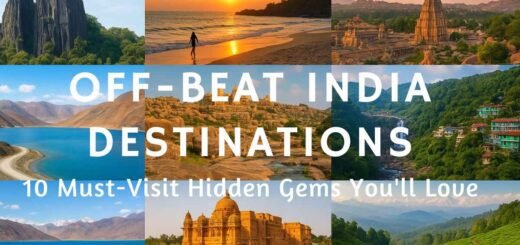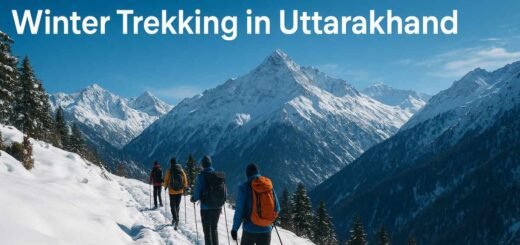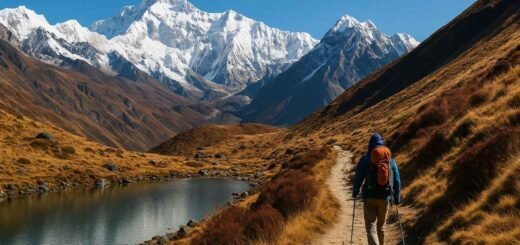Hidden Gems of Bhutan: 10 Magical Places You Must Visit Beyond Paro & Thimphu
Hidden Gems of Bhutan – Explore 10 offbeat places beyond Paro & Thimphu. Discover serene valleys, secret monasteries, and local adventures.
Hidden Gems of Bhutan unveil the untouched heart of the Himalayas — where time slows down and nature whispers serenity. Beyond the postcard-perfect Paro and Thimphu lie breathtaking landscapes, mystical monasteries, and charming villages rarely seen by tourists. This guide explores ten lesser-known wonders that showcase Bhutan’s cultural richness and natural beauty.
Contents
- 1 10 Hidden Gems of Bhutan You Must Visit
- 1.1 1. Haa Valley – The Land of Tranquility
- 1.2 2. Phobjikha Valley – Winter Home of the Black-Necked Cranes
- 1.3 3. Lhuentse – The Heart of Traditional Weaving
- 1.4 4. Trashi Yangtse – Sacred Art & Ancient Traditions
- 1.5 5. Bumthang – The Spiritual Core of Bhutan
- 1.6 6. Ura Valley – A Step Back in Time
- 1.7 7. Mongar – The Gateway to the East
- 1.8 8. Trashigang – The Jewel of the East
- 1.9 9. Zhemgang – Wildlife and Wilderness
- 1.10 10. Dagana – Bhutan’s Hidden Waterfall Haven
- 2 Quick Facts at a Glance
- 3 How to Reach
- 4 Best Time to Visit
- 5 Best Things to Do
- 6 Local Cuisine & Food to Try
- 7 Where to Stay
- 8 Shopping & Souvenirs
- 9 Seasonal Travel Insights
- 10 Nearby Attractions
- 11 Travel Tips
- 12 FAQs
- 13 Useful Links
10 Hidden Gems of Bhutan You Must Visit
1. Haa Valley – The Land of Tranquility
Nestled near the western border, Haa Valley remains Bhutan’s best-kept secret. With its emerald fields and sacred temples, it offers peace far from the crowds of Paro.
2. Phobjikha Valley – Winter Home of the Black-Necked Cranes
This glacial valley is a paradise for bird lovers and nature photographers. The Gangtey Monastery overlooking the valley adds spiritual grace.
3. Lhuentse – The Heart of Traditional Weaving
Known for its vibrant textiles, Lhuentse offers insight into Bhutanese craftsmanship and rural heritage.
4. Trashi Yangtse – Sacred Art & Ancient Traditions
Home to Chorten Kora and the ancient dzongs, this eastern gem brims with spirituality and history.
5. Bumthang – The Spiritual Core of Bhutan
Often called the “Switzerland of Bhutan,” Bumthang blends lush valleys with sacred monasteries and legends.
6. Ura Valley – A Step Back in Time
This quaint village preserves Bhutanese rural life, complete with farmhouses and ancient tales.
7. Mongar – The Gateway to the East
Adventure seekers love Mongar for its winding roads and unexplored trekking routes.
8. Trashigang – The Jewel of the East
A bustling hillside town where mountain views meet local culture, perfect for offbeat explorers.
9. Zhemgang – Wildlife and Wilderness
Home to rare golden langurs, Zhemgang is a haven for eco-travelers and wildlife enthusiasts.
10. Dagana – Bhutan’s Hidden Waterfall Haven
The lush forests and hidden waterfalls of Dagana are ideal for solitude seekers.
Quick Facts at a Glance
- Capital: Thimphu
- Currency: Bhutanese Ngultrum (BTN)
- Official Language: Dzongkha
- Best Season: October to May
- Visa Required: Yes (through licensed tour operator)
How to Reach
Fly into Paro International Airport, Bhutan’s only international gateway. From Paro or Thimphu, you can access these hidden gems via scenic road trips or domestic flights (to Bumthang or Yongphulla).
Best Time to Visit
The ideal months are October to December and March to May, offering crystal-clear skies, vibrant festivals, and comfortable weather for hiking.
Best Things to Do
- Trek through Phobjikha and Ura Valleys
- Attend local tsechus (festivals)
- Visit traditional weaving villages in Lhuentse
- Explore eco-trails in Zhemgang
Local Cuisine & Food to Try
Don’t miss Ema Datshi (chili cheese), Suja (butter tea), and Phaksha Paa (pork with red chilies) — hearty dishes that warm you in mountain air.
Where to Stay
Stay in eco-lodges in Phobjikha, farmstays in Ura, or heritage hotels in Bumthang for authentic Bhutanese experiences.
Shopping & Souvenirs
Pick up handwoven textiles, bamboo crafts, and Bhutanese incense from Lhuentse and Trashi Yangtse markets.
Seasonal Travel Insights
- Spring (Mar–May): Best for rhododendron blooms
- Summer (Jun–Aug): Green landscapes, occasional rain
- Autumn (Sep–Nov): Festival season
- Winter (Dec–Feb): Best for birdwatching
Nearby Attractions
- Tiger’s Nest Monastery (Paro)
- Dochula Pass
- Punakha Dzong
- Gangtey Goenpa
Travel Tips
- Carry Bhutanese currency for local markets
- Dress modestly inside monasteries
- Respect photography rules in temples
- Always travel with a licensed Bhutanese guide
FAQs
Q1: What are some hidden gems of Bhutan for nature lovers?
A: Phobjikha, Haa, and Zhemgang offer serene natural beauty, perfect for eco-travelers.
Q2: How can I reach Bhutan’s offbeat destinations?
A: Most are connected by scenic highways; domestic flights are available to Bumthang and Trashigang.
Q3: Is Bhutan safe for solo travelers?
A: Yes, Bhutan is one of Asia’s safest travel destinations.
Q4: What is the best time to explore hidden gems in Bhutan?
A: March–May and October–December provide ideal weather.
Q5: What’s the local language in Bhutan’s villages?
A: Dzongkha is official, but locals also speak regional dialects.
Hidden Gems of Bhutan reveal the country’s untouched beauty — valleys, monasteries, and mountain trails away from the tourist path. Pack your bags and discover Bhutan’s pure soul beyond Paro and Thimphu.


